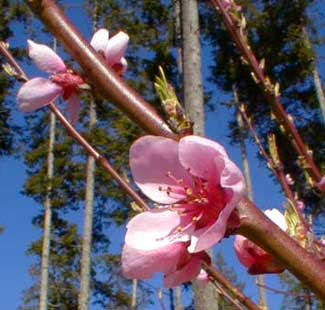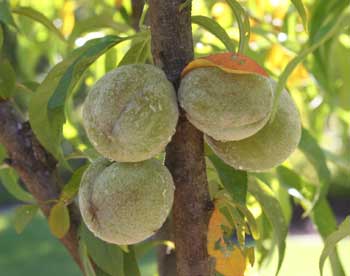
'Frost'
Semi-dwarf Semi-freestone Peach
"The air under the peach blossoms is a haze of pink."
-Carl Sandburg
(1878-1967)
(1878-1967)
"If you don't want my peaches, honey
Please don't shake my tree."
-Carl Perkins
(1932-1998)
(1932-1998)
Despite the potential great beauty of peach trees (Prunus persica), they are as a generality not ideal garden trees because they are host to such an array of diseases. Aphids, borers, leaf-curl fungus & other fungi that mar leaves or result in unexpected defoliation, tent caterpillars, bacterial leaf spot & twig canker, limb & twig gall, & powdery mildew are all much more likely problems with peaches than with hardy varieties of plums, cherries, or apples, hence less often seen in Northwest landscapes.
But a few modern cultivars are hardy enough for our wet seasons & winters & if provided with a perfect position in a garden unshaded by larger trees, they can thrive. If permitted to branch out into multiple trunks, they can be exquisite structurally.
'Frost' is one of the varieties that is resistant to peach-leaf curl, though no peach or nectarine is guaranteed totally immune. The variety is similar to the most commonly planted 'Redhaven' which likewise does nicely in northerly gardens. 'Frost' like 'Redhaven' blooms in March instead of the usual April expected of the majority of peaches, perhaps even a week or two ahead of 'Redhaven.' 'Frost' is very cold-hardy & could be grown to Zone 5. Here in Zone 8 its frost-hardiness is scarcely tested.
 A bare-root sapling for 'Frost' was planted (probably in 2002) in full sun at friends' property before they bought the place, a single odd-tree-out among the apple trees. Peaches generally require a second variety to pollinate well, but 'Frost' is self-fertile, & will produce mid-sized round fruits without a partner.
A bare-root sapling for 'Frost' was planted (probably in 2002) in full sun at friends' property before they bought the place, a single odd-tree-out among the apple trees. Peaches generally require a second variety to pollinate well, but 'Frost' is self-fertile, & will produce mid-sized round fruits without a partner. It would doubtless fruit better with a second variety nearby, but if fruit production were excessive as it can be on some trees, they'd need to be thinned down anyway, or the tree would be overworked & produce only stunted fruits.
Northwest summers are in the main not quite long enough to result in ripe peaches, though 'Frost' is the happy exception, getting a month's jump on production. But I remember my great-aunt Cora grew a self-fertile peach tree for its ornamental value amidst dwarf apple trees & hemmed around by rhodies & roses. Her tree produced many large peaches, which she harvested when the temperature dropped. They were never fully ripe so she made pickles out of them.
But 'Frost' by right of flowering early, & having mid-sized rather than large fruits, has every chance of producing ripe fruits, especially in years when Northwest summers are holding out warm into August when the peaches fully rupen with a skin-color of gold & red.
Peach blossoms appear late winter & early spring along grey branches, before leaves emerge, as shown in the March photo above (with trunks of western hemlocks visible in the background). Even if the summer isn't quite warm enough or long enough for the fruit to achieve sweetness, 'Frost' is even so a fine ornamental due to those bright pink flowers that more than rival flowering pink cherries, rendering 'Frost' a nice substitute for those locally over-used Japanese flowering cherries that are late-winter bloomers a week or two ahead of 'Frost.'
Peaches have been cultivated in China for millenia. They require full sun, organically rich acidic soil, & regular but never excessxive watering; although, if finest fruit production is unimportant, they can be fairly drought-hardy trees. Good drainage is a must & if water puddles around the base, expect the tree to be stressed & invite disease.
Pruning is essential if young trees are to develop strong limbs & trunks, as they may otherwise begin to droop under their own weight, & will be susceptible to breakage. Though often trained with a single trunk, its natural disposition is to fork into two, three, four or more trunks; if select trunks are preserved via artful pruning, the structure of the tree will thicken & the appearance will have rustic beauty even when leafless in winter.